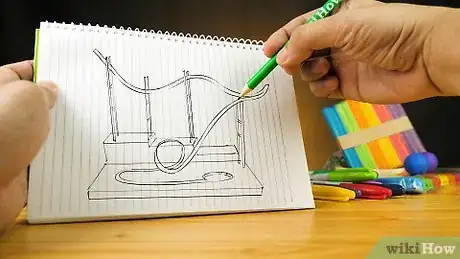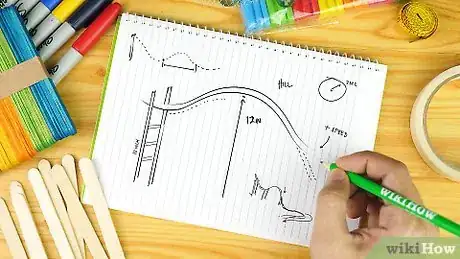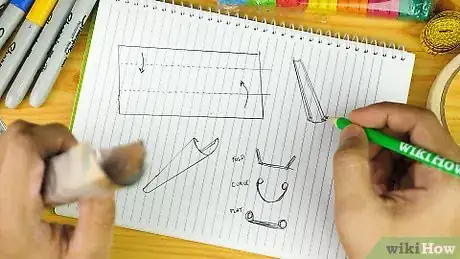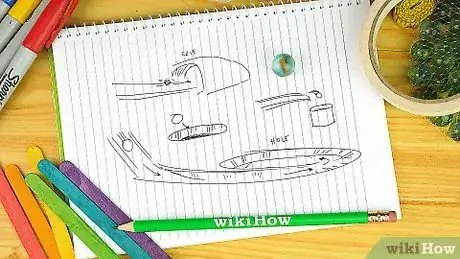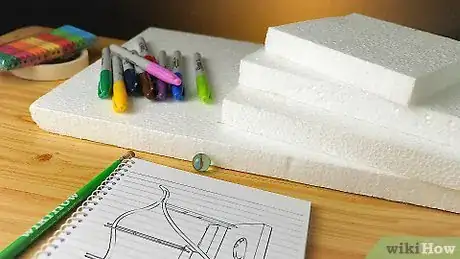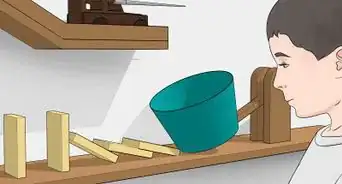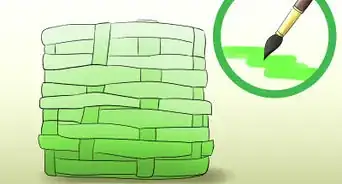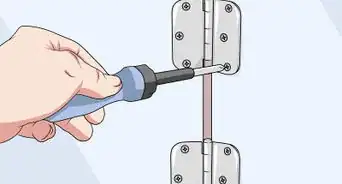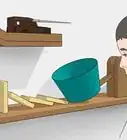This article was co-authored by California Science Center and by wikiHow staff writer, Megaera Lorenz, PhD. The California Science Center presents science learning for all ages through interactive exhibits, live demonstrations and exciting giant screen films. Its integrated approach includes an elementary school and education resource center, all in one location. In 2020, the Science Center's Virtual Hands-On Science Astroland and Adventureland Camp was run in partnership with wikiHow.
This article has been viewed 36,790 times.
If you’ve ever been on a roller coaster, you know how fun and exciting they are. They can also teach you a lot about how objects use energy to move. You can build your own mini marble roller coaster using simple materials like popsicle sticks, aluminum foil, and a Styrofoam base. The way you design the coaster is up to you, so get creative and challenge yourself to make your ride as fun, fast, and safe as possible!
Things You Should Know
- Create a base for your roller coaster using a foam board.
- Tape popsicle sticks between wooden skewers to make supports for your coaster.
- Fold aluminum foil into narrow channels to make your coaster's tracks.
Steps
Designing the Roller Coaster
-
1Draw at least 1 design in your notebook. Before you start building your roller coaster, grab your notebook and sketch some ideas. As you’re drawing, think about how it would feel to ride your roller coaster in real life.
- Your goal is to design a roller coaster that’s both fun and safe to ride!
-
2Include 1 or more hills that are at least 6 inches (15 cm) high. High hills are an important part of any fun roller coaster. Your coaster can have more than 1 hill, but plan to make at least one of them 6 inches (15 cm) or taller.
- A true hill needs both an upward and a downward slope. A tall downward ramp or slide with no slope leading up to it doesn’t count! You can include both hills and ramps in your design, though.
- Think about how you’ll get the marble moving. What will it take to get it going up a steep hill?
Did you know? When an object like a marble or a roller coaster car is at the top of a high hill, it has lots of potential energy—that is, energy that comes from its position. This energy comes from the force of gravity, which can pull the object down to the ground. Once the object starts moving, that potential energy turns into kinetic energy.[1]
Advertisement -
3Design a method to keep your marble on the track. A roller coaster where the riders can fly off the track isn’t very safe. As you’re creating your design, think about features you can build in to keep your marble where it belongs.
- For example, would it help to give your track high walls or railings? Can you create some sort of gutter or safety net to catch the marble in case it falls off?
- Try to guess which parts of the track are possible danger zones. Do you think your marble is more likely to fly off track going uphill or downhill? What about at curves in the track?
-
4Plan a way to stop your marble at the end of the track. This is another important safety feature for your roller coaster. What can you add to the end of your track to keep the marble from just rolling away?
- For example, what if you put a barrier at the end of the track? How can you prevent the marble from bouncing over the barrier?
Constructing the Coaster
-
1Make a base using the polystyrene board. Once you’re ready to build your roller coaster, you’ll need a good foundation to support it. Use your foam board as a base to anchor the upright pieces of your roller coaster, like the sticks that will help hold up the track.
- If you want, you can use your pencil or a marker to mark on the board where you want to put different parts of the track.
-
2Use popsicle sticks and skewers to support your track. To make those tall ramps and hills, you’ll need some sturdy upright pieces to hold up your track. Experiment with different ways to space out these pieces and make them stand up.
- For example, you could push the sticks into the foam board, or create clay “feet” to help them stand.
- Do some parts of the track need extra support? How can you make your support pieces shorter or taller?
- Remember, you need at least 1 hill to be 6 inches (15 cm) high or taller, so use your measuring tape or ruler to check the height of your hills.
-
3Build your track out of aluminum foil. Take the sections of foil and use them to create segments of track, then attach them to your support structure using tape. Remember, you’ll need to build the track so that the marble can stay on it without falling off easily!
- Does it help to use longer or shorter pieces of foil for some parts of the track?
- Do you think the pieces of your track are sturdy enough to hold up the marbles? What can you do to make them stronger?
-
4Get creative and experiment with your other materials. Think about interesting ways you can use your other materials, like the Model Magic clay, pipe cleaners, and tape. Can you use any of these materials to make your track and support structure stronger? What about building safety features for your track?
- For example, maybe you could use pieces of clay to support lower bumps or hills on your track, or construct a safety net for your marble to fall into using pipe cleaners.
-
5Test the track as you’re building it to make sure it works. As you create the different segments of your track, try sending the marble through to see if it works the way you want it to. If not, you can make adjustments to your design before building the next part.
- For example, if you’ve just built a big hill, try sending your marble over it. Does it have any trouble getting up the hill? What can you do to give it a better running start?
Testing It Out
-
1Experiment with different ways of launching your marble. Depending on how you made your track, your marble might need a little help to get started. See what happens if you just set it on the track and let it go, or try giving it a push.
- How is this different from a real roller coaster? How is it the same?
Did you know? Real roller coasters rely on potential and kinetic energy to work, just like your Rolling Roller Coaster model! The cars that the riders sit in don’t need engines to roll around the track. But they do need a little help to get started.[2] How do the cars climb the first hill on the roller coaster?
-
2Time how long it takes for your marble to finish the track. Use a stopwatch or a watch that shows seconds to check how long it takes for your marble to run the whole track, from launch to finish. Does it go fast enough to complete the track in 10 seconds or fewer?
- It can be helpful to have someone else hit the timer while you start the roller coaster.
- If you don’t have a stopwatch, try counting in “alligators” to count the seconds. If you say “alligator” after each number (“1 alligator, 2 alligator,” and so on), it will take you about 10 seconds to get to 10.
-
3Observe where the marble goes the fastest or slowest. You might notice that in some parts of the track, your marble goes faster or slower. Where does it usually speed up or slow down? Which part of your track do you think is the fastest?
- For example, does your marble go faster when it’s going uphill, or downhill? What about bends in the track?
-
4Investigate ways you could make your marble go faster. If you’re not satisfied with the speed of your roller coaster, think about things you could do to make it even faster. Would it help to make some parts of the track higher or lower? What about making the track longer or shorter? What if you changed the way you launched your marble?
- Once you come up with an idea, put it to the test! Try making adjustments to your track and see what happens.
Things You’ll Need
- Scissors
- Notebook
- Pencil
- Measuring tape
- Roll of masking tape
- Polystyrene sheet, 10 by 10 by 1 inches (25.4 by 25.4 by 2.5 cm)
- 10 sheets of aluminum foil
- 10 popsicle sticks
- 10 wooden skewers
- 6 pipe cleaners
- Markers
- Model Magic clay
- Marble
References
About This Article
To make your own rolling roller coaster, first get a piece of foam board to use as a sturdy base. Then, cut popsicle sticks in half and tape them between skewers to make the supports for your roller coaster. Stick the supports into the foam board. Now, fold up pieces of aluminum foil to make the tracks for your roller coaster, and rest the tracks on the supports. You can create inclines, steep drops, and even upside-down loops using the tracks. Decorate your roller coaster with clay, pipe cleaners, and other craft supplies. When you're finished, test out your roller coaster by dropping a marble on the track and watching it roll down to the very end. For tips on how to design your rolling roller coaster, keep reading!
